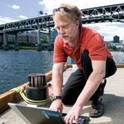
Article
Multiple Trophic Levels Fueled by Recirculation in the Columbia River Plume
Geophysical Research Letters
Sponsor
The National Science Foundation for the financial support for this work.
Document Type
Article
Publication Date
9-1-2010
Subjects
- Bioreactors -- Fluid dynamics,
- Columbia River Estuary (Or. and Wash.) -- Hydrodynamics,
- Sediment transport -- Mathematical models
Disciplines
Abstract
Large rivers represent gateways for the transport of terrigenous and anthropogenic material to the coastal ocean. Here we document a ?700 km2 recirculation or bulge associated with the Columbia River plume that retains recently discharged river water sufficiently to create a regional bioreactor. Fueled by a fluvial nitrate source, this feature stimulated growth across three trophic levels and may buffer this gateway system during periods of increased warming and stratification that lead to decreased ocean productivity, potentially enhancing production at multiple trophic levels and enriching surfacewaters far from the river mouth.
DOI
10.1029/2010GL044342
Persistent Identifier
http://archives.pdx.edu/ds/psu/7920
Citation Information
Kudela,R.M., et al. (2010), Multiple trophic levels fueled by recirculation in the Columbia River plume, Geophys. Res. Lett., 37, L18607.

Copyright 2010 American Geophysical Union